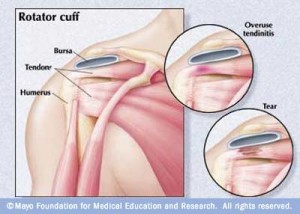Swimmer’s Shoulder – A Common Cause
One of the most common problems among swimmers are shoulder problems. This can be especially true for those new to the sport as they haven’t fully developed good form and those form issues turn into problems. It doesn’t take a very big flaw to cause a problem. Let’s assume it takes you 16 strokes to get across the pool, 8 strokes on each shoulder. If your average workout is 3,000 yards, that’s 120 lengths of the pool and 960 times that you rotate each shoulder. If you have even a small flaw in your stroke, the amount of repitition can easily cause a problem.
 Hands down the most common cause is poor body rotation. In fact, I can often diagnose the problem without even seeing a person swim. I ask a few questions and bingo! Swimming flat in the water will cause the tendons (see illustration) to be pulled or stretched as the arm is reaching behind you to recover above the water. This added friction will cause inflamation (which starts to compound the issue) and pain. It’s considered an overuse injury, but poor mechanics are the true culprit.
Hands down the most common cause is poor body rotation. In fact, I can often diagnose the problem without even seeing a person swim. I ask a few questions and bingo! Swimming flat in the water will cause the tendons (see illustration) to be pulled or stretched as the arm is reaching behind you to recover above the water. This added friction will cause inflamation (which starts to compound the issue) and pain. It’s considered an overuse injury, but poor mechanics are the true culprit.
The fix? Rotate your body more. The motion of the shoulder shouldn’t be much more than an up and down motion rather than the circular motion that most people think of. As the arm finishes the pull and begins to recover, the body rotates to one side allowing the shoulder to simply lift. When the recovery is complete and the hand enters the water, the body rotates back allowing the shoulder to essentially lower as you pull through the water. If you find yourself moving your shoulder in large, circular motions, then chances are you are swimming too flat in the water.
Is this the only way to get swimmer’s shoulder? Heck no. There are plenty. For example, when one muscle group develops more than another in your shoulder (too much bench press, etc) the over developed muscle group will create an imbalance and pull on the joint. You can also run into problems on the back side of your shoulder if you cross the midline of your body too much during your pull. The list goes on…
Be patient as tendons and ligaments receive very little bloodflow, so it will take them longer to heal than muscle injuries. Reduce your volume or do exercises in the pool that don’t hurt the problemed shoulder such as: other strokes, stroke drills and kick sets. A little time off will do your shoulders some good. Once the pain subsides, have someone take a look at your stroke and make the necessary adjustments. The key is not to drift back into your old habits.

Is the Dryland workouts for swimmers Valid? can u give me any reference, for knowing the Protocol. And for Dryland shoulder exercises; and how to check shoulder strengthening, any other outcomes can be taken (Like agility, endurance, strength) and their references, specify. Please send to my email address: srknth70@gmail.com
I just searching for dryland workouts for swimmers, i cant find proper Protocol ( regarding, repetition maximum, number of sets, How many times per Day / week / month) Particularly for shoulder. And their valid references please specify. Send me to srknth70@gmail.com